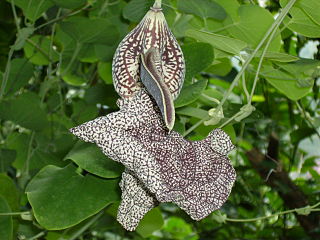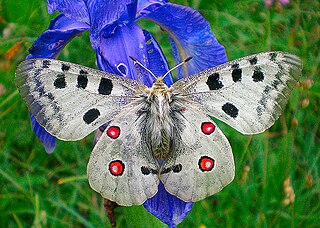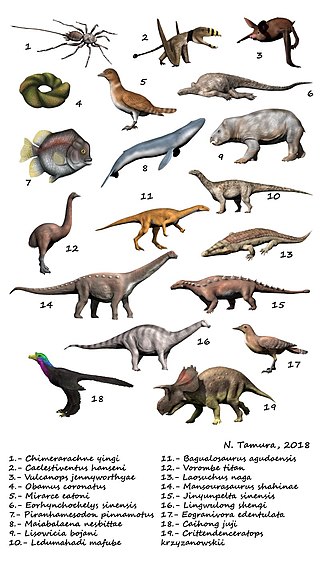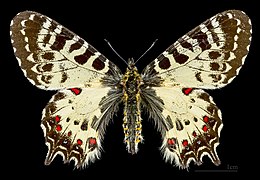
The horned lark or shore lark is a species of lark in the family Alaudidae found across the northern hemisphere. It is known as "horned lark" in North America and "shore lark" in Europe.

Swallowtail butterflies are large, colorful butterflies in the family Papilionidae, and include over 550 species. Though the majority are tropical, members of the family inhabit every continent except Antarctica. The family includes the largest butterflies in the world, the birdwing butterflies of the genus Ornithoptera.

Aristolochia is a large plant genus with over 500 species that is the type genus of the family Aristolochiaceae. Its members are commonly known as birthwort, pipevine or Dutchman's pipe and are widespread and occur in the most diverse climates. Some species, like A. utriformis and A. westlandii, are threatened with extinction.

The Apollo, also called the mountain Apollo, is a butterfly of the family Papilionidae.

The chalkhill blue is a butterfly in the family Lycaenidae. It is a small butterfly that can be found throughout the Palearctic realm, where it occurs primarily in grasslands rich in chalk. Males have a pale blue colour, while females are brown. Both have chequered fringes around their wings.

Bhutanitis lidderdalii, the Bhutan glory, is a species of swallowtail butterfly, which is found in Bhutan, parts of northeastern India and of Southeast Asia. A spectacular insect much sought after by collectors, the species epithet is after Dr R. Lidderdale, from whose collection the butterfly was first described by William Stephen Atkinson in 1873. Listed under CITES Appendix II, the status of the butterfly has been recorded as rare by some authorities but as being of least concern in 2019 by the Red Book of the IUCN.

Apatura ilia, the lesser purple emperor, is a species of butterfly native to most of Europe and east across the Palearctic. It is named for its similarity to the purple emperor butterfly.

Zerynthia is a genus of swallowtail butterflies placed in the subfamily Parnassiinae. The genus has a complex history; a multiplicity of names have been applied to its species.

Zerynthia rumina, the Spanish festoon, is a butterfly belonging to the family Papilionidae. It is a widespread species in Iberia and frequents most habitats.

Zerynthia polyxena, the southern festoon, is a butterfly belonging to the butterfly family Papilionidae.

Allancastria is a genus of Palaearctic swallowtail butterflies in the subfamily Parnassiinae. Five species are known. The genus has a complex history.

Allancastria cretica is a butterfly belonging to the family Papilionidae. It was described by Rebel in 1904. It is found only on the Greek island of Crete where it is, then, an endemic species. The taxon was originally described as a variation of Allancastria cerisyi, then treated as its subspecies.

Parides gundlachianus, the Cuban cattleheart, is a species of butterfly in the family Papilionidae. It is an endemic species found only in Cuba. The name honours the Cuban naturalist Juan Gundlach.

It is widely agreed that the evolutionary lineage of the grey wolf can be traced back 2 million years to the Early Pleistocene species Canis etruscus, and its successor the Middle Pleistocene Canis mosbachensis. The grey wolf Canis lupus is a highly adaptable species that is able to exist in a range of environments and which possesses a wide distribution across the Holarctic. Studies of modern grey wolves have identified distinct sub-populations that live in close proximity to each other. This variation in sub-populations is closely linked to differences in habitat – precipitation, temperature, vegetation, and prey specialization – which affect cranio-dental plasticity.

Paleontology or palaeontology is the study of prehistoric life forms on Earth through the examination of plant and animal fossils. This includes the study of body fossils, tracks (ichnites), burrows, cast-off parts, fossilised feces (coprolites), palynomorphs and chemical residues. Because humans have encountered fossils for millennia, paleontology has a long history both before and after becoming formalized as a science. This article records significant discoveries and events related to paleontology that occurred or were published in the year 2018.
This paleomammalogy list records new fossil mammal taxa that were described during the year 2019, as well as notes other significant paleomammalogy discoveries and events which occurred during that year.
This paleomammology list records new fossil mammal taxa that were described during the year 2022, as well as notes other significant paleomammalogy discoveries and events which occurred during 2022.





















